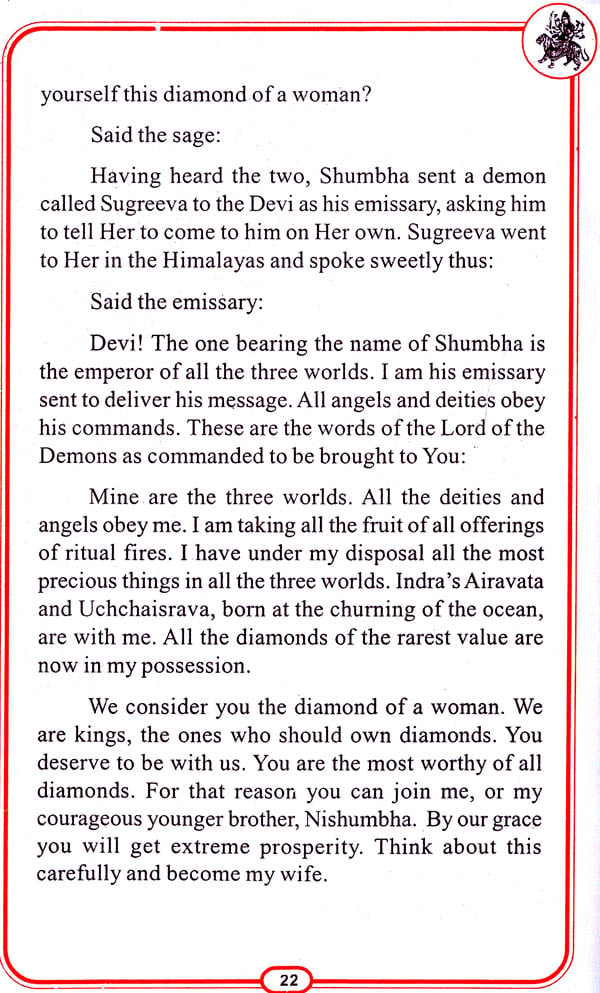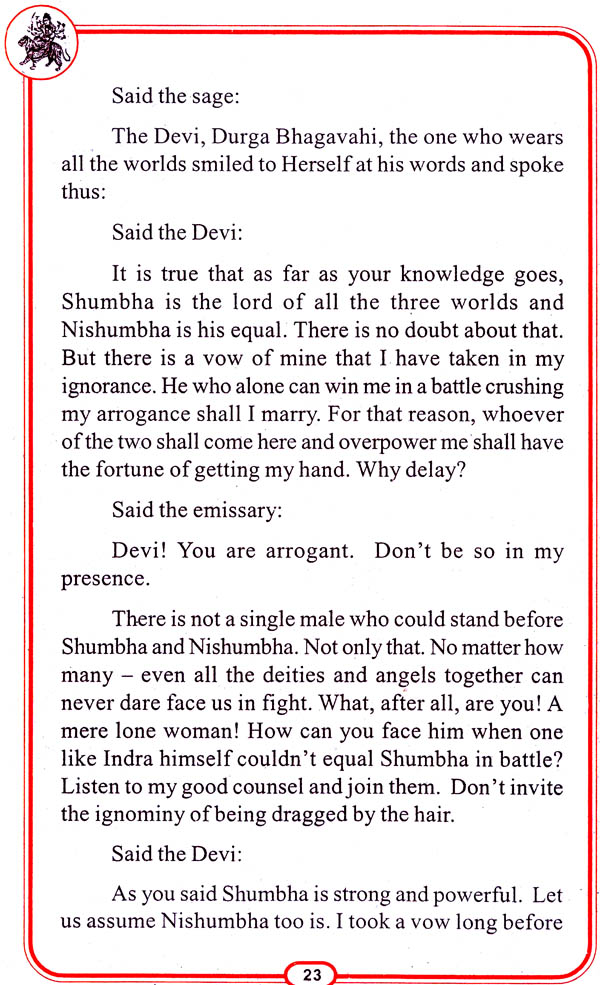
Durga Saptashati
Book Specification
| Item Code: | IDG948 |
| Author: | V.V.B Rama Rao |
| Publisher: | RICHA PRAKASHAN |
| Pages: | 54 |
| Cover: | Paperback |
| Other Details | 8.5" X 5.5" |
| Weight | 50 gm |
Book Description
From the Back of the Book
Durgasaptasati, from the Markadeya Purana deals with a description of the effulgent acts of the Supreme Mother. A mere reading of it in a devout frame of mind has an ennobling influence. The present work aims at giving a simple narrative of the events described in that part of the purana, the epic.
A reading, repetition or contemplation on the power and glory of Devi, Chandi or Durga would bless us with peace and joy.
About the Author
Dr. V.V. B. Rama Rao (b. 1938) an academic and a retired ELT (English Language Teaching) Professional, is a creative writer and translator with lots of Published work to his credit.
Smt. Rama Rao (b. 1941) with a Devout bent of mind, had her education in Hindi Medium institutions. The two have been married for the last forty four years.
The supreme Creatrix is seen as the Yogamaaya of Vishnu in Durgasapatashati, which belongs to the Tantra Sastra tradition. Sri T. Y.Kapali Sastry who has written extensively on tantra describes it as "the science of mantras":
"By the use of the mantra, mystic syllables, powers of concentration are developed to open the centres that are ordinarily closed in the human system. And these centres, when opened, become steps in a stair case in the rising tiers of consciousness functioning as windows upon a wider existence, of a larger world teeming with forces and beings whom one may contact on the way, or ignore and move onward towards the highest reach, the Supreme Consciousness. The Tantric Yoga at its highest aims at the realization of the highest consciousness and the powers natural to it."
If so, what use is a translation of the Mantric text into an alien language like English? However, though Durgasptashati is mantric in utterance, it is also dramatic in impulsion. Knowing its content is a first step for an aspirant. He can now model himself on the humble King Suratha and the merchant Samadhi who receive knowledge of the Divine Mother from the sage Sumedha. The aspirant should attain preliminary understanding of the Divine Forces as also of the diverse Powers of Darkness before receiving the deep vibrations of the mantras. An English translation of Durgasaptashati is thus a welcome and appropriate help for the educated Indian who has been alienated from his rich tradition.
Recitation of the text of Durgasaptashati is itself mantra japa. According to Kapali Sastry, "Every verse in it is treated as mantra in the Katyayani Tantra. And this is done in spite of the fact that all the 700 verses do not describe the glory of the goddess. as there are many verses which narratives relate to the origin and end of the stories of the Devi." But there is a remarkable integral togetherness of the tale and the prayers addressed to the Mother. It is as if the Mother's assurance of constant guardianship helps humanity cross the ocean of samsaara. Indeed the text itself is the Mother, our Guardian eternal.
The Durgasaptashati speaks of the Divine Mother's personalities as Mahakaali, Mahalakshmi and Maha Saraswati. Of course, Her personalities are inexhaustible and they are quite close to us. We only need to invoke Her in the right meditative spirit. Sri Aurobindo, the great yogi, had mastered the experience and conveyed a portion of his visionary understanding in The Mother.. Mahasaraswati is described thus:
"A Mother to our wants, a friend in our difficulties, a persistent and tranquil counsellor and mentor, chasing away with her radiant smile the clouds of gloom and fretfulness and depression, reminding always of the ever present help, pointing to the eternal sunshine, She is firm, quiet and persevering in the deep and continuous urge that drives us towards the integrality of the higher nature."
Dr. Rama Rao has indeed performed an important service to our spiritual life by bringing us closer to the great scripture, Durgasaptashati, with this easy to read and faithful translation. I thank him for this gift to the aspirant for the life divine and invoke the Divine Mother's blessings upon his venture:
"She is the golden bridge, the wonderful fire.
The luminous heart of the Unknown is she,
A power of silence in the depths of God:
She is the Force, the inevitable word,
The magnet of our difficult ascent
All nature dumbly calls to her alone
To heal with her feet the aching throbs of life
And break the seals on the dim soul of man
And kindle her fire in the closed heart of things.
And here shall be one day her sweetness 's house. "
Even after half a century of winning national Independence, we could not stage a come back to learn our devbhasha with any alacrity.
Given the present scenario, political, social and economic, it may take several decades for us to realize what we have missed. More of our educated people know English better than our own languages.
It may take years for the average Indian to look to Sanskrit for purposes by far nobler, and for that reason higher, than the merely mundane.
Hence this effort - inadequate and imperfect though - to present the essence of a great composition in English for those many strayed faraway from our own invaluable tradition.
(Durgasaptasati is from Markandeya Purana Chapters 81-93)
Theists are believers in the Supreme Power as the basis of all creation, maintenance and destruction of all things and all beings in the universe. Hinduism believes in the Divine and we worship the Divine, Supreme Being. Supreme is the term for Brahman also. The Upanishad defined it as Brahman, the one without beginning or end, the limitless.
Jnaana. the quality and state of 'knowingness'. Truth, Beauty, Goodness, Light and Joy are all aspects of the Supreme. We believe that Existence, Knowledge and Freedom from Grief alone are the manifestation, the Supreme, Brahman. That is without quality or appearance, uirguna and niraakara, without alternative, and from that alone Maaya has taken birth. It is the prime reason for all worlds and the universe including the power that sustains all. Maaya (great illusion) and Brahman are dharma and dharmi, masculine and feminine, the indivisible, same. They are also called prakriti and purusha (broadly the Male and Female principles).
Purusha enters Prakriti in a part (amsa) and thus becomes one called "Jeeva". Jeeva comes to be under the control of Prakriti (Avyaktam or Maaya) and under the influence of , my ness' and forgetting the knowledge of the Self becomes subject to the agencies of Moha and Grief. Thus distancing himself from Light and Joy, owing to 'Karma', Jeevi gets entangled in the wheel of life-death. This is the stage of difficulty. Disentangling one's self from this and once again merging one's self into the state of everlasting joy and light is salvation, Mukti . This is the end of human life, prushaartha. The means for the achievement of the goal are three: Bhakti (devotion), Jnaana (Knowledge or Gnosis) and Vairaagya (total unentanglement and detatchment). Saadhana (Practice) and upaasana (contemplation and worship as laid down in the Holy Books) are paths that lead to accomplishment.
Truth variously called Brahman, Atman, and God is 'unarticulable', beyond definition. It transcends the distinctions of sex: it is described as being neither male, female or neutral. It is referred to as all the three sexes. Rasovaisaha (masculine): om tat brahma - Tat twam asi (neutral) and parorajasi saa vadom devi aksharam brahma sammitam (Feminine). Pranava (the cosmic sound of OM) and the unexpendable are symbols of Atman, God or Brahman. God can be contemplated as any of these. Those who believe that Purusha is masculine call Him Siva, those who call that Vishnu are Vaishnavites. Those who worship Her as Sri Maata, the Supreme Mother and Adi Sakti are saakteyaas.
Purusha and Prakriti are construed as father and mother. In practical experience we see the female having greater responsibility for bringing up children. The part of Prakriti is unique, even in the body. The mother bestows all attention on the child, sustaining and fostering the offspring. Our scriptures say that the life of a motherless infant is insufferable. For these reasons, it has been our tradition to worship Prakriti, the female principle. The Supreme Lord is looked upon in the shape of both Prakriti and Purusha. The Supreme Mother is considered to be the source from which all energy and powers flow. For people like us, for ends both mundane and other-worldly, worship of Prakriti is essential.
The worship of the Supreme Mother is called Sri Vidya also. That is the worship of Lalita and Chandi. Both are the same: only the names and forms are two: in fact there are many describing the same Supreme. Lalita, is based on ponchadasi mantra with fifteen aksharas (letters). Chandi is worshipped with the navaakshara, nine lettered mantra. The description of the power and the glory of Chandi in saptashati, seven hundred slokas or hymns, is called, Chandisaptashati , Durgasaptashati and also Devi Maahatmya. The basic secret is described thus:
| Foreword | v | |
| Introduction | vii | |
| Chapter I | The Slaying of the demon duo Madhu and Kaitabha | 1 |
| Chapter II | The Slaying of Demon Mahisha's Armies | 6 |
| Chapter III | Slaying the Demon Mahisha | 10 |
| Chapter IV | The Song of Praise Sung by Sakra and other Angels | 13 |
| Chapter V | The Colloquy between the Devi and the Emissary | 18 |
| Chapter VI | The Slaying of the Demon Dhumralochana | 25 |
| Chapter VII | The Slaying of Chanda and Munda | 27 |
| Chapter VIII | The Slaying of the Demon Raktabeeja | 29 |
| Chapter IX | The Slaying of Nishumbha | 33 |
| Chapter X | The Slaying of the Demon Shumbha | 36 |
| Chapter XI | The Song in Praise of Narayani | 39 |
| Chapter XII | Thus Spake the Bhagavati | 45 |
| Chapter XIII | The Devi Granting Boons to King Suratha and the Vysya | 49 |
| Aaratee Durgaa Jee Kee | 52 |







